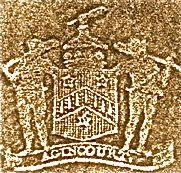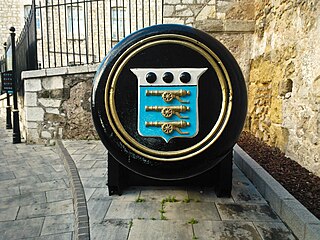The Master-General of the Ordnance (MGO) was a very senior British military position from 1415 to 2013 with some changes to the name, usually held by a serving general. The Master-General of the Ordnance was responsible for all British artillery, engineers, fortifications, military supplies, transport, field hospitals and much else, and was not subordinate to the commander-in chief of the British military. In March 2013 the holder was titled as "Director Land Capability and Transformation", but still sat on the Army Board as Master-General of the Ordnance; in September 2013 the post was eliminated.

Wodehouse is an English surname and barony.

Earl of Yarmouth is a title that has been created three times in British history, once in the Peerage of England and twice in the Peerage of Great Britain. The first creation came in the Peerage of England in 1679 in favour of the politician and scientist Robert Paston, 1st Viscount Yarmouth. He had already been created Baron Paston and Viscount Yarmouth in the Peerage of England in 1673. He was the son of William Paston, who had been created a Baronet, of Oxnead in the County of Norfolk, in the Baronetage of England in 1641. Lord Yarmouth was succeeded by his son, the second Earl. He notably served as Treasurer of the Household between 1687 and 1689. He had no surviving male issue and the titles became extinct on his death in 1732.
This is an incomplete list of people who have served as Lord Lieutenant of Norfolk. Since 1689, all Lord Lieutenants have also been Custos Rotulorum of Norfolk.
Charles Howard, 2nd Earl of Nottingham of Effingham, Surrey was the second son of Charles Howard, 1st Earl of Nottingham. His mother was the former Catherine Carey. From 1615 to 1624 he was styled Lord Howard of Effingham before he succeeding his father in the latter year as 2nd Earl of Nottingham.

Catherine Howard, Countess of Nottingham, was a cousin, lady-in-waiting, and close confidante of Elizabeth I of England. She was in attendance on the queen for 44 years.
This is a list of people who have served as Custos Rotulorum of Norfolk.
This is a list of people who have served as Custos Rotulorum of Nottinghamshire.

The Lieutenant-General of the Ordnance was a member of the British Board of Ordnance and the deputy of the Master-General of the Ordnance. The office was established in 1545, and the holder was appointed by the crown under letters patent. It was abolished in 1855 when the Board of Ordnance was subsumed into the War Office.
The high sheriff is the oldest secular office under the Crown and is appointed annually by the Crown. The High Sheriff of Norfolk was originally the principal law enforcement officer in Norfolk and presided at the assizes and other important county meetings. Most of the responsibilities associated with the post have been transferred elsewhere or are now defunct, so that its functions are now largely ceremonial. There was a single high sheriff serving the two counties of Norfolk and Suffolk until 1576.
Norfolk was a County constituency of the House of Commons of the Parliament of England then of the Parliament of Great Britain from 1707 to 1800 and of the Parliament of the United Kingdom from 1801 to 1832. It was represented by two Members of Parliament. In 1832 the county was divided for parliamentary purposes into two new two member divisions – East Norfolk and West Norfolk.
This is a list of Sheriffs of Norfolk and Suffolk. The Sheriff is the oldest secular office under the Crown and is appointed annually by the Crown. He was originally the principal law enforcement officer in the county and presided at the Assizes and other important county meetings. After 1576 there was a separate Sheriff of Norfolk and Sheriff of Suffolk.
Sir John Townshend MP, of Raynham Hall in Norfolk, was an English nobleman, politician, and knight. He was the son of Sir Roger Townshend and Jane Stanhope. He was also a soldier and Member of Parliament. He was killed in a duel with Sir Matthew Browne in August 1603.

Oxnead is a lost settlement in Norfolk, England, roughly three miles south-east of Aylsham. It now consists mostly of St Michael’s Church and Oxnead Hall. It was the principal residence of the Paston family from 1597 until the death of William Paston, 2nd Earl of Yarmouth in 1732. Under Sir William Paston (1610–1663), Oxnead was the site of several works by the architect and sculptor, Nicholas Stone, master-mason to Kings James I and Charles I.
Sir Henry Heydon was the son of John Heydon of Baconsthorpe, Norfolk, 'the well-known opponent of the Paston family'. He married Anne Boleyn, the daughter of Sir Geoffrey Boleyn, great-grandfather of Henry VIII's queen Anne Boleyn.
The Cromwell family is an English aristocratic family. Its most famous members are: Thomas Cromwell, 1st Earl of Essex, and Oliver Cromwell, the Lord Protector. The line of Oliver Cromwell descends from Richard Williams, son of Thomas Cromwell's sister Katherine and her husband Morgan Williams.





